Our Know-How
All viticulture, winemaking and ageing work is carried out on the domaine Veuve
Maurice Lepitre.
The numerous types of care we provide to our vines and our wines reflects all the best that this incredible terroir has to offer!
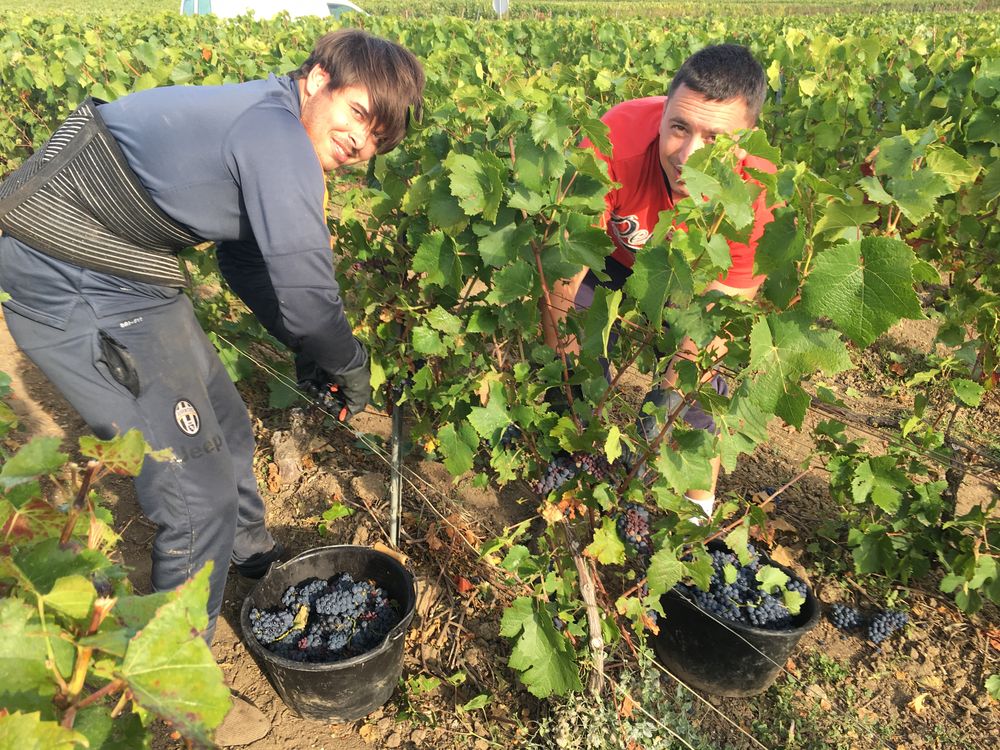
Harvest
The basic yield, the quantity
of grapes to be picked per hectare each year, is set by decree.
Hand-picking of whole bunches of grapes is compulsory and we sort the grapes by plot to eliminate spoiled grapes.
Learn more
Maturity analysis
Each week, as the grapes begin to change color (veraison), samples are taken from several plots to be analyzed.
The maturity of the grapes defined mainly by the sugar and acidity levels are decisive in choosing a harvest date in our village, which takes place every year during August or September.
Regulation of yields
The basic yield of the harvest is regulated by the INAO (organization in charge of the regulation of the French agricultural products with Protected Designation of Origin) revisable upwards or downwards according to the quality and the quantity of the grapes of the AOC Champagne.
Hand picking
In Champagne, the harvest is obligatorily manual in order not to damage the berries which must arrive intact at the pressing. The grape-pickers therefore pick whole bunches to avoid tinting the juice by its skin.
Sorting by plot
More than 100,000 harvesters work in teams of 4 or 5 per hectare. The grape pickers have a window of about three weeks to work because beyond this period, the grapes risk to rot. They are sorted at the time of picking.
Pressing
centre under conditions that limit their oxidation and
maceration, where they are weighed and pressed within a maximum of 18 hours.
From 4000 Kg of grapes (constituting a “marc”), we obtain 2 qualities of grape juice (“must”): the first fraction corresponds to 20.5 hectolitres of “cuvée” and the second corresponds to 5 hectolitres of “taille” each with their own organoleptic characteristics.
Since 1990, we have been using our own horizontal pneumatic
membrane press, approved in terms of quality by the CIVC
(Champagne Comitee). It guarantees us the best possible pressing quality whatever the climatic conditions of the harvest according to the strict regulations of the AOC Champagne.
As part of our “high environmental value” approach, we
responsibly manage our by-products and waste by sending them to the distillery. Wine effluents (water used to clean the press, grape boxes and vats) are recovered for treatment so as not to harm the environment.
Learn more
Pressing center
The grapes are transported to the pressing center in crates with drainage holes to avoid oxidation and maceration. As soon as they arrive at the pressing center, the grapes are weighed and recorded in a register. After weighing, they are taken to the press to be pressed within 18 hours. This reactivity avoids the coloring of the juice because ¾ of the wines of Champagne are elaborated from grapes with black skin. Moreover, it avoids the oxidation of the juice in order to preserve its most delicate aromas. It is the pulp that contains the organoleptic compounds and the elements necessary for effervescence and only the pulp can give the clear juice and the desired paleness.
Fractionation
A press book is kept to identify each “marc”. From a “marc” of 4000 kilos of grapes, the traditional unit of pressing, only 25.50 hectoliters of must can be extracted. The pressing is divided by separating the first juices extracted, 20.50 hl which constitute the “cuvée”, from the next 5 hl, called “taille”. The musts have very specific analytical characteristics. The cuvée, which represents the purest juice of the pulp rich in sugar and acids (tartaric and malic), gives wines of great finesse, with subtle aromas and a good freshness in the mouth and a better aptitude for aging. The size, also rich in sugar with less acids, but more mineral salts (potassium in particular) and coloring matters, produces wines with intense aromatic characters, fruitier in their youth, but with a lesser longevity.
Our press
During the pressing, the plastic food membrane will inflate with air to press the grapes in a slow and progressive way. Its pressure increases in steps of 0.2 bars
On the opposite side, the horizontal cage is equipped with drains that collect the juice and ensure its flow to the juice collector for the belons (open tanks).
The retrousse, reworking of the pond cake between each greenhouse, is done by deflating the membrane and rotating the cage. The unloading is automatic by opening the doors of the press and making continuous rotations of the cage.


Hygiene and high environmental value
Between each marc, the press must be emptied and cleaned with water. As part of the sustainable viticulture approach, at the end of the pressing, the “aignes” (solid residues of the “marcs”) must be sent to the distillery and the wine effluents are recovered to be treated so as not to harm the environment.
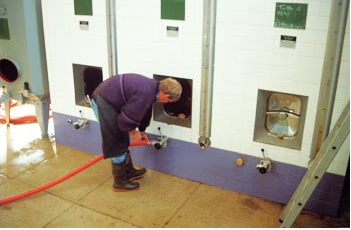
Winemaking
and to facilitate the settling of the must.
The must resulting from the pressing process settles for a few hours through the settling process allowing its first clarification by eliminating its impurities.
After racking, the must will undergo alcoholic fermentation, allowing the transformation of sugars into alcohol under the action of yeasts.
The wine thus obtained will
be softened and will gain in stability through malolactic
fermentation, which gives it a brioche note.
A second stage
of clarification will follow in order to improve the clarity of the wine as much as possible.
Learn more
Sulphiting
The juice that flows out of the press is collected in tanks called “belons” in Champagne. Sulphiting (addition of sulphur dioxide or SO2) takes place continuously as soon as the juice leaves the press, at doses varying from 6 to 10 g/hl depending on the grape variety, the sanitary state of the grapes and the fraction (size or cuvée).
Through its antiseptic power, sulfiting plays an important role in the control of undesirable indigenous bacteria and yeast populations. By its antioxidant power, it participates throughout the winemaking process in the preservation of the physicochemical and sensory characteristics of the wines. It also facilitates the settling stage that follows.
The settling
The settling consists of a static decantation of the juice. In the first hours, a flocculation of the enzymes naturally present in the juice or added occurs. The flocs formed sediment at the bottom of the tank with the other particles in suspension in the juice (fragments of skins, seeds, etc…) forming the sludge. After 12 to 24 hours, the sludge is separated from the must (clear juice) by racking. The lees (between 1 and 4 % of the volume) are declared and sent to the distillery.
After clarification, the racked musts are sent to the vat house for the first stages of the vinification. This involves the fermentation of these clear juices in order to obtain fruity and aromatically frank wines. The content of each vat is clearly identified by the mention of the fraction, the grape variety, and the year.
The alcoholic fermentation
The first fermentation of Champagne wines is the alcoholic fermentation which transforms the must into wine. The yeasts “eat” the sugar and produce alcohol and carbon dioxide, as well as other components (higher alcohols, esters) that build the sensory characteristics of the wine.
The settled musts are chaptalized if necessary, the goal being to obtain a maximum of 11% alcohol by volume at the end of fermentation.
The “yeasting” with selected yeasts (Saccharomyces cerevisiae) allows a greater control of the fermentation process. This transformation lasts about fifteen days and generates a strong rise in temperature which it is essential to regulate, around 18-20°C, in order to limit the loss of aromas and the risks of stopping the fermentation.
The monitoring of the fermentation, thanks to the control of the temperature and the density must be realized daily.
Malolactic fermentation
Our strategy is to carry out the malolactic fermentation on our wines at the end of the alcoholic fermentation. The transformation of malic acid into lactic acid gives our wines aromatic notes of brioche and butter and a certain suppleness by reducing their acidity. This fermentation also generates other compounds that will modify the organoleptic profile of the wine. The temperature of the vat room is maintained around 18°C and the vats are inoculated with selected freeze-dried bacteria. The evolution of the malolactic fermentation is assessed by monitoring the total acidity. It lasts between four and six weeks, after which the wines are racked and clarified.
Clarification
It is carried out by kieselguhr filtration. Then our wines are stabilized in the natural cold of our winery. Free of their solid particles, our “basic” wines are now clear and are called “clear wines”, ready to be blended.
Blending
What underlies this approach has always been for us the search for a certain harmony between the notes,
so that no single one dominates and one feels a sense of balance in the mouth.
Learn more
The Assembly
The blending of our wines from our three grape varieties allows us to create contrasts that complement each other thanks to the body of the Pinot Noir, the fruitiness of the Meunier and the finesse of the Chardonnay.
From one year to the next, the climatic conditions of the Champagne region vary. The quality of the grapes, and therefore of the musts and wines that will be made from them, depends on various factors such as frosts, sunshine, rainfall, etc. The blending of our wines from different years tends to balance the resulting diverse qualities.
Our parcels all located in Rilly-la-Montagne allow us to reveal the specific qualities of this vintage: our wines from this unique terroir guarantee the constancy of its aromas.
Moreover, the technique of massal selection applied on our vineyard and transmitted by our ancestors allows us to maintain the continuity of flavors of our wines, thanks to the varietal diversity of our vines (old vines of 70 years) conferring a particular aromatic typicity.
Each year in January, we have a real palette to imagine the best complementarity between our wine from the previous harvest and our reserve wines, always in a desire to maintain the specificity of the style and the durability of our champagne (of a vinous and balanced style in mouth)
However, when the opportunity arises, we reflect a remarkable year with a vintage if the flavors and balance of the wine from that year are judged to be sufficiently exceptional, so as not to have to call upon reserve wines.
Finally, the art of blending is a prelude to the other stages of the Champagne method – tirage, prise de mousse, ageing on deposit, riddling, disgorging and dosage – which will later amplify the harmony created by the blend.
Bottling & "prise de mousse"
will take place. This is the capture of the effervescence!
Learn more
Bottling & « prise de mousse »
The bottling consists in the “bottling” of our wine which will undergo the fermentation in the bottle, intended to make the wine sparkling, hence the name “prise de mousse”.
To achieve this fermentation, we add to the wine a liqueur called “tirage”, composed of cane sugar, leaven and a stirring additive.
The yeast is a culture of selected yeasts, previously acclimatized to the wine environment. We choose the yeasts that best match our wines in order to reveal the greatest complexity upon contact with them during aging.
In accordance with the regulation that forbids decanting (from half-bottle to jeroboam), the wine will be marketed in the bottle where it was elaborated. The bottle of Champagne, which can only be in glass, answers a specific schedule of conditions because it must, among other things, resist to a very strong pressure and to numerous manipulations.
After filling, the bottles are hermetically sealed with a polyethylene stopper called a “bidule” completed with a crown cap, then lowered into cellars at 12°C where they are placed “on laths”, i.e. lying down and stacked, row upon row, in pallet boxes.
Then comes the “prise de mousse”, which lasts 6 to 8 weeks, where the yeasts consume the sugar and release into the wine, in addition to alcohol and carbon dioxide, esters and higher alcohols that will also contribute to the sensory characteristics of the wine.
Ageing on lees
They will remain in contact with the wine for many years, and the complexity of its aromas develop due to the interactions made with the lees during this time.
In order for our wines to reach their full maturity in contact with the lees, we let them age between 4 and 9 years.
Learn more
Ageing on lees
Protected from the light, the bottles remain in our cellars for a long period of maturation. The cellars play a major role in this important stage of the wine making process thanks to their relatively constant temperature, around 12°C.
The lees are essentially made up of the yeasts that have multiplied in the bottle and form a deposit. At the end of the fermentation process, the yeast gradually dies out and autolyses: its cellular content degrades and releases molecules that will interact with those of the wine and undergo slow transformations
At the same time as autolysis, a small amount of oxygen enters the bottle through the draft stopper, while a little carbon dioxide escapes. The seal is therefore not absolute. The choice of the stopper is a very important parameter depending on whether you are looking for a more or less rapid evolution.
Maturation on the lees therefore combines two phenomena :
– the autolysis of the yeasts
– the slow oxidation resulting from the corking.
In Champagne, they combine ideally given the fine and delicate structure of the wines. This crucial stage of the elaboration brings specific aromas to the wines of Champagne and allows the progressive blooming of the aromas of maturity and plenitude, known as tertiary.
By law, at least 15 months must elapse between bottling and shipping, 12 of which must be on lees. The period is extended to 3 years for vintages.
This legal period, already important compared to other sparkling wines*, is longer for us: depending on our vintages, we estimate that between 4 and 9 years are necessary for our wines to reach their full maturity on the lees.
*The European regulation only imposes a minimum period of 90 days for sparkling wines. The wines of Champagne are the only ones to know such a long maturation.
After such a long ageing in the quiet and mysteries of our underground galleries, our bottles are regularly stirred by hand to gather the deposit in their neck.
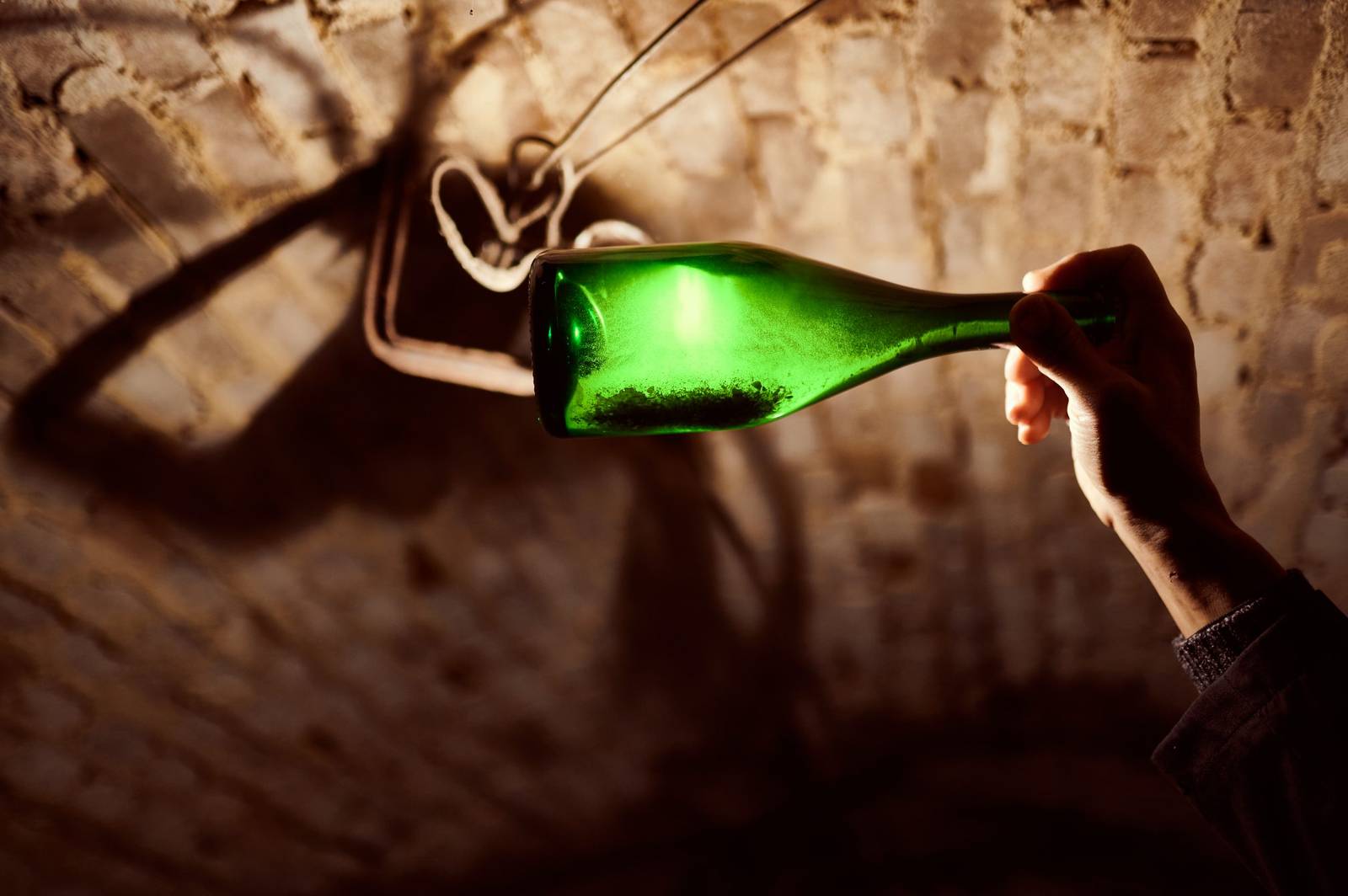
Riddling
After this long period of rest, the wine must be given back its clarity by removing the deposit that formed during the foaming process by riddling.
The bottles are placed on wooden racks, first horizontally and then gradually raised a quarter of a turn to the left and then to the right, allowing the deposit to collect in the neck of the bottle.
Learn more
The bottles are placed on wooden racks first horizontally and then gradually lifted a quarter turn to the left and then to the right, allowing the deposit to accumulate in the bottle neck.
This stirring is done manually
These successive balances, reproduced for centuries by the cellarers, allow the deposit to capture the smallest particles and thus obtain a perfectly clear wine.
A bottle is stirred by hand an average of 25 times over a month and a half.
Before being sent for disgorging, the bottles are stored “on point” (in racks, upside down).
Manual disgorging
Learn more
Manual disgorging
This is a crucial moment in the life of the wine, after the time of maturation on the lees when no external event disturbed the wine.
To do this, the neck of the bottle is immersed in a glycol solution at about -27°C, forming an ice cube in the neck that traps the sediment inside.
The bottle is held upside down and opened by turning it upright so that the pressure expels the deposit without letting too much wine escape.
When opened, the internal pressure allows the ice cube to be ejected with a minimum loss of wine and pressure.
During this operation, a small amount of oxygen enters the bottle and, together with the dosage liquor added at this stage, contributes to the evolution of the wine’s aromatic characteristics.
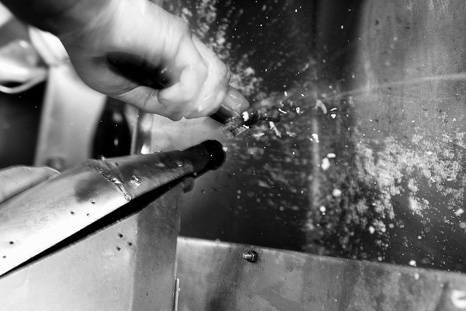
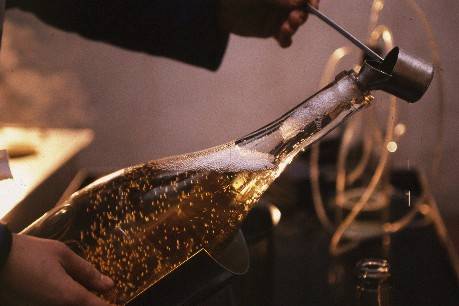
Dosage
It corresponds to the addition of a small quantity of liqueur.
Learn more
Dosage
The liqueur de dosage, also called “liqueur d’expédition” is composed of cane sugar dissolved in wine.
The quantity of liqueur used for the dosage depends on the type of wine you want to obtain:
– Sweet more than 50 grams of sugar per liter
– Semi-dry between 32 and 50 grams of sugar per liter
– Dry between 17 and 32 grams of sugar per liter
– Extra dry between 12 and 17 grams of sugar per liter
– Brut less than 12 grams of sugar per liter
– Extra brut between 0 and 6 grams of sugar per liter
For a content of less than 3 grams and if the wine has not been the subject of any addition of sugar, one can use the mention “brut nature”, “pas dosé” or “dosage zéro”.
The role of dosage in the sensory evolution of the wine can be weak or important.
We wish to preserve the integrity of the personality of our wine with a liqueur as neutral as possible. The wine lost during disgorging is replaced by a little of the same wine combined with cane sugar.
While ensuring a maximum of watertightness, the cork does not completely prevent gas exchanges. As with the tirage cork, a little oxygen penetrates over time and the wine continues to evolve.
Corking & Labelling
stage of its ageing begins. The bottles are then vigorously shaken (wrist stirring) to ensure the homogeneity of the wine and the liqueur, and their controlled limpidity (mirage).
Then they return to the cellar for another 6 months before being marketed.
The last step is to carefully dress the bottles with their labels and place them in their box to protect them during the long journey to your table!
